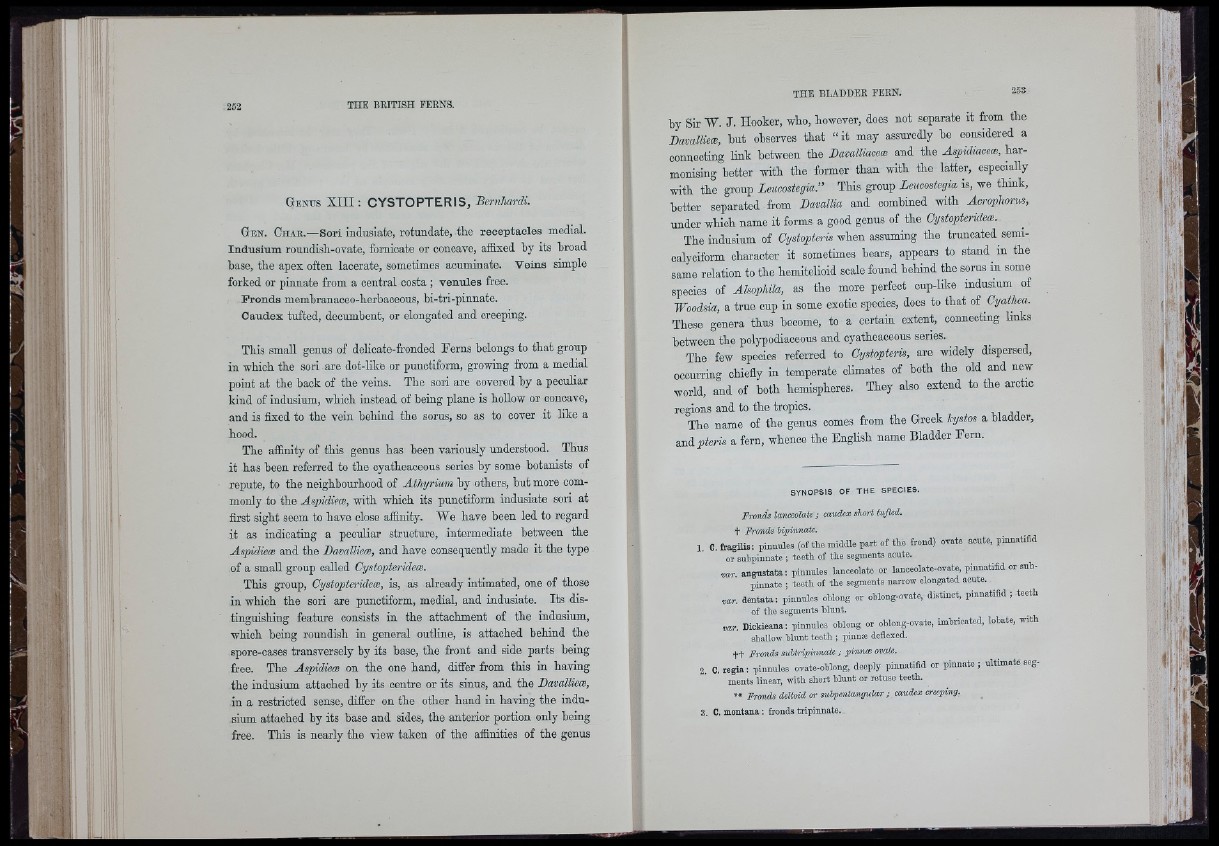
ílití '
líi:l 1
!l i
Genus X II I : CYSTOPTERIS^ Bernhardi.
Gen. Char.—Sori indusiate, retúndate, the receptacles medial.
Indusium roundish-ovate, fornicate or concave, affixed hy its broad
base, the apex often lacerate, sometimes acuminate. Veins simple
forked or pinnate from a central costa ; venules free.
Fronds memhranaceo-herbaoeous, hi-tri-pinnate.
Candex tufted, decumbent, or elongated and creeping.
This small genus of delicate-fronded Ferns belongs to that group
in which the sori are dot-like or punctiform, growing from a medial
point at the back of the veins. The sori are covered by a peculiar
kind of indusium, which instead of being plane is hoUow or concave,
and is fixed to the vein behind the sorus, so as to cover it like a
hood.
The affinity of this genus has been variously understood. Thus
it has been referred to the cyatheaeeous series hy some botanists of
repute, to the neighbourhood of Athyrium hy others, but more commonly
to the Aspidieæ, with which its punctiform indusiate sori at
first sight seem to have close affinity. We have been led to regard
it as indicating a peculiar structure, intermediate between the
Aspidieæ and the Davallieæ, and have consequently made it the type
of a small group called Cystopterideæ.
This group, Cystopterideæ, is, as already intimated, one of those
in which the sori are punctiform, medial, and indusiate. Its distinguishing
feature consists in the attachment of the indusium,
which heing roundish iu general outline, is attached behind the
spore-cases transversely hy its base, the front and side parts heing
free. The Aspidieæ on the one hand, differ from this in having
the indusium attached by its centre or its sinus, and the Bamllieæ,
in a restricted sense, differ on the other hand in having the indusium
attached hy its base and sides, the anterior portion only heing
free. This is nearly the view taken of the affinities of the genus
hy Sir W. J. Hooker, who, however, does not separate it from the
DavalUeai, hut observes that “ it may assuredly he considered a
conneoting link between the Bavalliacem and the Aspidiaccw, harmonising
better with the former than with the latter, especially
with the group Leucostegia.” This group Leucostegia is, we think,
better separated from Davallia and combined with Acrophorus,
under which name it forms a good genus of the Cystopteridem.
The indusium of Cystopteris yAien assummg the truncated semi-
calyoiform character it sometimes hears, appears to stand in the
same relation to the hemitelioid scale found behind tho sorus in some
species of Alsophila, as the more perfect cup-like indusium of
Woodsia, a true cup in some exotic species, does to that of Cyathea.
These genera thus become, to a certain extent, conneoting links
between the polypodiaceous and cyatheaeeous series. ^
The few species referred to Cystopteris, are widely dispersed,
oocurring chiefly in temperate climates of both the old and new
world, and of both hemispheres. They also extend to the arctic
regions and to tlie tropics.
The name of the genus comes from the Greek hystos a bladder,
w J pteris a fern, whence the English name Bladder Fern.
SYNOPSIS OF THE SPECIES.
Fronds lanceolate ; caudex short tufted.
t Fronds Upinnate.
1 C. ftagUis; pininúes (of th e middle p a rt of th e frond) ovate acnte, pinnatifid
or suhpinnate ; te e th of th e segments acnte.
var. a n g u s ta ta ; pinnules lanceolate or lanceolate-ovate, pinnatifid or suh-
p in n a te ; te e th of th e segments narrow elongated acute.
var. d en ta ta ; pinnnles ohlong or oblong-ovate, distinct, pinnatifid ; te e th
of th e segments hlnnt.
var. Dickieana; pinnules ohlong or oblong-ovate, imbricated, lobate, with
shaUow h lu n t te e th ; pinnæ deflexed,
f t Fronds suUripinnate ; pinnm ovate.
2. C. re g ia : pinnules ovate-oUong, deeply pinnatifid or pinnate ; u ltima te segments
linear, with short h lu n t or retuse teeth.
** Fronds deltxdd or subyentangular ; caudex creeping.
3. C. montana : fronds tripinnate.
•l-.V-'l
i f f t i l ' ;
'il
i i
Ï I
1;
i-i'.-'
iibi. j
ìà
' i r
4.-JL